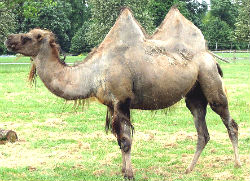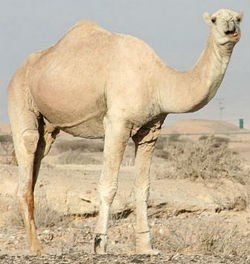Bactrian Camel-Dromedary Hybrids
Mammalian Hybrids
EUGENE M. MCCARTHY, PHD GENETICS, ΦΒΚ
|
The Bactrian camel differs from the Dromedary in having two humps as against the latter’s one.
—Aristotle
History of Animals 2.1 |
Bactrian camel-dromedary hybrids (Camelus bactrianus x C. dromedarius) are intentionally produced in captivity. Formerly, they may have also occurred naturally when the now-reduced ranges of these animals still came into contact.
Hybrids of this type are partially fertile in both sexes. Köhler-Rollefson (1991, p. 6) says, “The well-documented data from Turkmenistan contradict frequent statements in the literature (for example, Gray, 1972) that hybrid males are sterile. They also suggest that there is no genetic barrier between Bactrian camels and dromedaries, or if one exists, it is partial at best.”
These hybrids have been bred for centuries in western Asia (Anatolia, Syria, Kazakhstan, Afghanistan, Kurasan, and Iran). The main intent in breeding hybrid camels has been to produce a stronger pack animal. Usually the Dromedary serves as the dam in this cross because the resulting hybrids are considered superior to the product of the reciprocal cross, a situation that parallels normal practice in breeding the common mule, which is nearly always the product of mating between a mare and a jackass.
As early as the 10th century The geographer and traveler Abu al-Hasan Ali ibn al-Husayn al-Masudi (c. 896-956) noted that superior offspring are produced with the cross in this direction (Zirkle 1935, p. 29). Breeders keep small numbers of Bactrian females on hand to produce pure Bactrian males for crossing. These hybrids are still produced by the thousands in Afghanistan, Iran, Russia, and Turkey. The cross was formerly common, too, in zoos.
The hybrids are larger (up to 2.3m at hump and weighing 900-1000kg), more tolerant and easier to work than either parent. They also mature faster.
Kushner and Kitaeva (1938b) reported that F₁ females are larger than parental females (708 ± 25 kg vs. 666 ± 22 kg in Bactrian and 621 ± 17 kg in Dromedary). According to Tapper (1985), hybrids can carry loads approaching 500 kg. Dromedaries can carry only 200-300 kg, and Bactrians, much less.
Among the Shahsevan of Azerbaijan, this hybrid, known as the när, was the preferred animal for carrying the full tent and its appurtenances “which together weigh nearly half a ton” (Tapper 1985, p. 59). Blood profiles were also superior in F₁ hybrids.
Lakoza (1938a) gives an account of an expedition investigating camel breeding in Turkmenistan, Uzbekistan, Kazakhstan, and southwestern Russia, where the ranges of these camels overlap. Data were collected on ~27,000 camels, and camel hybrids were investigated in large numbers. The F₁ showed heterosis with respect to height (180.48 cm. vs. 172-173 cm in parents), body length and chest depth and width. Lakoza says, “The advantage over the parents was exhibited by the F₁ at all the ages examined.”
Blagovescenskii (1963) states that “hybrids between the dromedary and Bactrian are larger, produce more milk and meat and do more work than either purebred.” Hybrids are hardier and apparently also live longer. They also tolerate a broader range of temperatures than do their parents, an example of breeders producing desirable traits through hybridization. Thus, in The Journal of the Asiatic Society of Bengal, Hutton (1842, pp. 1184-1185) states that
This hybrid camel is in much repute among the northern tribes, and furnishes them at all seasons with an invaluable beast of burthen in a climate where neither one nor the other of the true species could be made available throughout the year. Art may be said therefore to have furnished what nature has denied them. The two humped camel is said to be so impatient of heat that it cannot endure the summer warmth even of so northerly a country as Bokhara, and this I can readily give credence to, since I had lately an opportunity of watching the habits of one of these animals which I purchased at Candahar. No sooner did the sun (even in December and January) fall upon the side of the yard where this animal usually stood to feed, than he walked over to the shade of the opposite buildings, as if conscious that his woolly coat was not adapted for summer weather.
During the warm months therefore the Bactrian Camel would not properly be available in more favoured climates than its own, and during that season, the Bokhara people would be deprived of their "Desert ships."
Again, the Dromedary, or one-humped male, can on the other hand endure but a moderate degree of cold, and the northern tribes would thus for many months be deprived of its services.
To obviate these evils they have crossed the breeds and obtained an animal capable of enduring alike the heats of summer and the cold of winter. His limbs are large and powerful. his chest broad and ample. his shoulder strong and heavy to bear the jolts and shaking he experiences in ascending and descending the rugged mountain passes and defiles through which, heavily laden, he is doomed to travel for long and fatiguing marches.
No beast could be better adapted for the work he has to perform, or the climates he has to endure, for in him are united the perfections and capabilities of both species. His constitution derived from both enables him alike to undergo the rigors of a northern clime and the heats of the southern districts to which he travels.
The shape of the head is like a Bactrian’s. They also have a beard and shaggy legs like a Bactrian, but no long hair on the shoulders. With successive backcrossing to Bactrian, there is first a single hump with two raised regions, then two humps with fused bases, then two separate humps. In F₂ hybrids, the F₁-type hump and both of the two types of humps seen in purebreds can occur, as well. According to Lakoza (1938a) “in certain very important camel-breeding regions nearly the entire stock consists of hybrids of various grades.” Because they have a single hump, F₁ hybrids are often mistaken for Dromedaries. However, the hump is usually more flattened than that of a pure Dromedary. Statements that male hybrids of this type are sterile (e.g., Gray 1972, p. 161) are incorrect (Peters and von den Driesch 1997; Potts 2004).
Potts notes that the remains of hybrid camels are known from ancient archaeological sites such as Troy, early Islamic Pella, Jordan, and Mleiha, United Arab Emirates (Jasim 1999; Uerpmann 1999, pp. 111-113). The earliest remains are those from Troy which date to the Roman/Parthian era.
Camel figurines of Parthian age from Seleucia exhibit the hump indentation characteristic of hybrids (Bulliet 1975, Fig. 1980). In his Library of History, completed c. 30 BCE, Diodorus Siculus (2.54.6) notes that in the region north of Arabia Felix (the Roman name for Yemen) camels of various kinds were kept, some capable of carrying ten medimni (about 900 lbs). As Bulliet (1975) points out, these latter were probably hybrids, since neither pure parental type is capable of carrying such burdens. Potts suggests that on the Iranian Plateau breeders were already hybridizing camels at the time of the Assyrian Empire.
|
Are humans hybrids?
|
By the same author: Handbook of Avian Hybrids of the World, Oxford University Press (2006).
References: Blagovescenskii 1963; Bulliet 1975; Dennler de la Tour 1971; Eversmann 1823 (p. 91); Hartmann 1869; Galik et al. 2015; Gray 1972; International Zoo Yearbook 1961, 1965, 1966, 1967, 1968, 1969, 1970, 1971, 1972, 1973, 1974, 1978, 1982, 1983, 1984/1984, 1990; Lakoza 1938a, 1938b; Leese 1927 (p. 133); Köhler-Rollefson 1989, 1991; Kolpakow 1935; Kushner and Kitaeva 1938b; Potts 2004; Tapper 1985. Internet Citations: CAMEL.
Most shared on Macroevolution.net:
Human Origins: Are we hybrids?
On the Origins of New Forms of Life
Mammalian Hybrids
Cat-rabbit Hybrids: Fact or fiction?
Famous Biologists
Dog-cow Hybrids
Georges Cuvier: A Biography
Prothero: A Rebuttal
Branches of Biology
Dog-fox Hybrids

